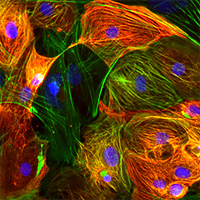Unlocking cardiomyocyte heterogeneity: the role of transcription factors
Meeting the challenges of heart disease with stem cell research
Cardiovascular disease has a significant impact on global health and the world economy (Benjamin et al. 2017). For example, heart failures such as strokes or infarcts can cause irreversible damage to cardiac tissue and are potentially deadly medical emergencies. Therefore, researchers are working to characterize cardiomyocytes (which are involved in the restoration of cardiac tissue) as part of the ongoing effort to develop tools for treating heart disease. We discussed some of the methods and challenges of cardiomyocyte research with Jared Churko, PhD, who is currently the Director of the iPSC Core and an Assistant Professor in the Department of Cellular and Molecular Medicine at the University of Arizona. His lab is studying the mechanisms of heart disease by utilizing human induced pluripotent stem cells (hiPSC) to generate cardiac cell types.
In a recent article, Jared Churko and colleagues studied the hiPSC-cardiomyocyte transcriptome and identified different cardiomyocyte subpopulations based on RNA-seq single-cell analysis (Churko et al. 2018). To better understand these subpopulations, the authors knocked out transcriptional regulators using CRISPR technology and identified three transcription factors involved in hiPSC-cardiomyocyte differentiation. These transcription factors could potentially be used to enrich for cardiomyocytes in specific developmental stages with the desired functional characteristics needed to treat various cardiac diseases.
Dr. Churko visited Takara Bio recently and we sat down with him to talk about his research, as well as the benefits and limitations of single-cell RNA-seq as applied to hiPSC-derived stem cell analysis. Here are some excepts from our conversation.
Can you describe your project?
My research focuses on how heart cells—the cells that keep your heart beating—are different from each other and how we can generate them in culture. In the future, we hope to use these new heart cells to heal damaged hearts in people who have an underlying heart condition.
There are different types of specialized heart cells. How does your research show what’s happening in the model system you are using?
Certain diseases only affect certain varieties of heart cells, so it’s important to be able to make different types of heart cells. For example, if you have an infarct or ischemia in your ventricular cells, you want to make sure you use ventricular cells to repair the resulting damage. This is important because if you add an electrical-type cell like a nodal cell instead, you will cause irregular beating in the ventricular region of the heart. My research is focused on making sure we’re engineering new heart cells that are properly tuned for the area of the heart where the disease is occurring, so that in the future they can be used to attempt to cure the disease.

Figure 1. Identification of hiPSC-CM subpopulations by single-cell RNA-seq. A monolayer cardiomyocyte differentiation protocol was used to assess how single-cell populations change over time. Single-cell RNA-seq was performed on Day 0, Day 5, Day 14, and Day 45 of differentiation and 10,376 cell states were identified using Iterative Clustering and Guide-gene Selection (ICGS) and Seurat-canonical correlation analysis (CCA) software. A t-SNE plot was generated using AltAnalyze to visualize the expression of ICGS-associated markers during the different days of differentiation. Twenty distinct cell populations were observed and could be attributed to populations representing pluripotent stem cells (PSC), definitive endoderm (DE), mesoderm (MESO), ectoderm (ECTO), stromal, neural crest (NC), endothelial cells, and early, mid or late cardiomyocyte progenitors. Image adapted from Fig. 1c of Churko et al. 2018, which can be accessed here, and used under Creative Commons Attribution 4.0 International license.
Why is single-cell RNA seq important for your work?
It’s due to the resolution that you get. Although you get a lot of data from bulk sequencing, single-cell RNA seq allows you to distinguish between different subtypes and to look at different transcripts at a single-cell level, versus compiling all your data using a bulk RNA-seq method. With a single-cell method, a single population of cells that you are interested in can be isolated and analyzed, keeping other cell populations for different projects or different kinds of studies. This is of major importance, because if a certain cancer cell occurs at a frequency of 0.001% in a population of cells, that wouldn't be detected using bulk sequencing. But if single-cell sequencing is performed on that particular cell, its specific gene expression profile can be analyzed and targeted therapeutics can be developed, versus getting more noise from the other cells that you’ve also sequenced using bulk methods.
What are the limitations of the technologies used in your work?
The biggest limitation is adding understanding to the data—being able to say what it means. For example, "What's important?", "What genes are important?", and "What are you using as your reference?" The biggest concern is not whether we can get the data now, but actually acquiring enough background knowledge to make sense of it, so we can use it downstream.
We are excited to learn how innovative methods are applied to generate advances in research. Jared's research confirmed CRISPR knockouts of the transcription factors with PCR using our PrimeSTAR GXL DNA Polymerase followed by Sanger sequencing. The library used for single-cell RNA-seq analysis was generated with our SMARTer Ultra Low RNA Kit for the Fluidigm C1. We are inspired to see how he used cutting-edge tools to find solutions to his research problems.
References
Benjamin, E. J. et al. Heart Disease and Stroke Statistics—2017 Update: A Report From the American Heart Association. Circulation 135, e146–e603 (2017).
Churko, J. M. et al. Defining human cardiac transcription factor hierarchies using integrated single-cell heterogeneity analysis. Nat. Commun. 9, 4906 (2018).
Single-cell analysis elucidates cardiomyocyte differentiation from human induced pluripotent stem cells
Learn how researchers used the ICELL8 Single-Cell System to develop a method for transcriptomically characterizing the differentiation of human iPSCs into cardiomyocytes.
Takara Bio USA, Inc.
United States/Canada: +1.800.662.2566 • Asia Pacific: +1.650.919.7300 • Europe: +33.(0)1.3904.6880 • Japan: +81.(0)77.565.6999
FOR RESEARCH USE ONLY. NOT FOR USE IN DIAGNOSTIC PROCEDURES. © 2025 Takara Bio Inc. All Rights Reserved. All trademarks are the property of Takara Bio Inc. or its affiliate(s) in the U.S. and/or other countries or their respective owners. Certain trademarks may not be registered in all jurisdictions. Additional product, intellectual property, and restricted use information is available at takarabio.com.






